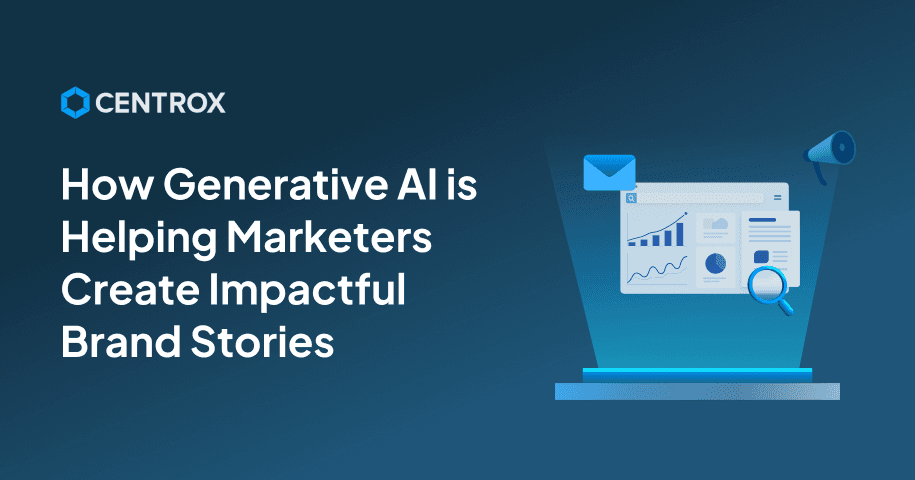How Generative AI is Helping Marketers Create Impactful Brand Stories?
Learn how Generative AI helps marketers craft personalized brand stories. Explore models, benefits, and challenges to create engaging content.
9/5/2025
artificial intelligence
7 mins

In today's digital era, where information flows within a fraction of a second, catching attention and promising impact has been a real challenge for creators and marketers. Additionally, the rising competition and evolving trends raise the need for having a Gen AI-powered tool in marketing that can work as a smart assistant.
Gen AI in marketing isn't just about automating workflow; it will eventually help in elevating creativity, speeding up, and streamlining workflow. Such tools will help brands build tailored stories that resonate with consumers' preferences.
With our article, we will explore how Gen AI in marketing is powering creative ideas, what methodologies are working behind it, and learn about learning some real-world applications. This will help you get all the required information that you need before making a decision.
How Conventional Marketing Practice isn't Enough?
Creating empowering brand stories that not just catch attention but also encourage consumers to go through them entirely is resource and time-intensive. Conventional marketing practices overly hold dependency on strategists, designers, and editors, which sometimes burdens them and results in delayed or compromised creatives. This causes in creating stories that don't match user interests, and eventually becomes unable to drive the expected output.
Gen AI in Marketing
Generative AI is transforming marketing by enabling brands to craft personalized stories, create compelling visuals, and automate campaigns. From text to imagery, it empowers marketers with creativity, efficiency, and scale while redefining customer engagement and storytelling strategies.
Why is Gen AI becoming Important For Marketing?
The growing competition, increasing number of choices, and reduced attention span are emerging as huge hurdles for today's marketer. During such times, coming up with interesting brand stories instantly within the limited availability of resources is challenging, ultimately restricting the brand from achieving the desired results. Here, a Gen AI-powered tool can become an additional support that can assist in several tasks without feeling tired or overwhelmed. During an interview, Sam Altman said:
“AI will do 95% of what marketers use agencies, strategists, and creative professionals for today.”
From finding the inspiration to help brainstorm the idea, and finally performing its execution, a Gen AI solution can eventually become a trustworthy addition. This not only makes creativity convenient, but also personalized according to the target persona's interests and likings.
Gen AI Models for Creating Marketing Stories
Generative AI has great potential for driving various marketing needs. Through its intelligent model, it extends applications that ensure attractive, consistent, quality creative assets for marketing campaigns. Gen AI models promise efficiency with enhanced creatives, making storytelling a bit easier for you. Below, we list a few Gen AI models with some applications that they can power for marketing space:
1. Transformers
- How They Work: “Transformers have an attention mechanism that finds the relationships between all words in a sentence instead of just looking at the previous one. Having this ability allows them to understand context in depth and provide text that flows naturally, making them ideal for storytelling and brand communication.” ( Ashish et al., 2023)
- Form of Application: Text Generation — These transformers can be used for ad copy, blogs, campaign scripts, and customer stories generation. This Gen AI model functions by predicting the most contextually relevant next word, ensuring coherent narratives that align with customer needs.
- Benefit: Such an AI-driven application produces fluent, human-like text that can be hyper-personalized according to preference.
- Challenge: The transformer-based application holds the risk of hallucinations and requires fine-tuning to maintain a consistent brand voice.

2. Generative Adversarial Networks (GANs)
- How They Work: “GANs, or Generative Adversarial Networks, have two models: one is a generator that creates fake data (like images), and the discriminator model then works to assess whether the output looks real or not. With the passage of time, this adversarial process achieves enhanced ability to produce highly realistic visuals.” (Pourya et al., 2021)
- Application: Creative Image & Video Ad Generation - GANs can be utilized to create lifestyle visuals, synthetic brand ambassadors, or product scenes. This model functions by being trained on large image datasets to resemble real-world visuals that support brand storytelling.
- Benefit: GANs have the unique ability to generate high-quality visuals at scale without relying on stock photos, making it extremely helpful in creating impactful stories.
- Challenge: Despite its amazing ability, it still holds training instability, and can be a reason for ethical risks, such as deepfakes or brand misuse.

3. Diffusion Models
- How They Work: Diffusion models are trained with an image made of pure noise, and then they slowly start removing the noise in steps, which is learned from patterns of training data. With this procedure, they can generate highly detailed and imaginative images from simple text prompts.
- Application: Creative Visuals & Illustrations - Diffusion models can be used for creating realistic branded images, artistic ads, and immersive campaign visuals. By progressively denoising an input image until it reflects prompts aligned with the campaign theme, it extends the desired outcomes.
- Benefit: The Diffusion model can create highly customizable, detailed, and creative assets that align well with provided instructions.
- Challenge: But these diffusion models are computationally expensive and require a strong prompt design for consistent output.

4. Variational Autoencoders (VAEs)
- How They Work: “VAEs compress the provided input data into a latent space (a simplified representation) and then further decode it back into output data. By tweaking the latent variables, it creates new variations of the original input while keeping the core features intact.” (Rafael et a., 2022)
- Application: Content Variations - VAE can generate multiple storylines, ad versions, or design alternatives for A/B testing. This responsibility is fulfilled by it by tweaking latent representations to explore different creative angles without retraining.
- Benefit: These VAEs have ensured efficient production of multiple versions quickly, which makes such tools a convenient, handy tool, especially for A/B testing applications.
- Challenge: Although they can provide several choices, sometimes the generated output might not be sharp and detailed.

Future of Gen AI in Marketing
Gen AI efforts to revolutionize workflows aren't stopping here. In the future, we can anticipate Gen AI tools taking care of the entire marketing life cycle. This will allow creators and strategists to focus on enhancing the core business storytelling, making it more tailored and result-oriented. The following are a few futuristic marketing applications that Gen AI can power:
1. Hyper-Personalized Real-Time Campaigns
In the future, Gen AI-driven tools will be able to analyze live customer interactions across different devices and instantly generate tailored ads, stories, or offers. Instead of making static campaigns like today, brands will be able to provide dynamic storytelling that will evolve in real time according to customer emotions, behavior, context, and taste.
2. Autonomous Creative Directors
The Future Gen AI solution will work as an end-to-end campaign manager. This tool will be handling the entire cycle from conceptualizing, designing, testing, and optimizing content with minimal human input. By autonomously storyboarding visuals to editing videos and measuring performance, AI will function like an intelligent creative director, reducing time-to-market and maximizing ROI.
Gen AI Empowering your Marketing Stories
Conventional marketing struggles to deliver the personalized, engaging stories today’s audiences expect. Generative AI enhances storytelling by making brand narratives adaptive, visually attractive, and scalable.
Transformers personalize campaigns, GANs and Diffusion create immersive visuals, and VAEs generate endless variations for testing. By doing so, it's not just bringing efficiency; it’s taking a leap toward autonomous marketing that continuously evolves with customer needs.
For decision-makers, the actionable path forward is clear: pilot Gen AI projects, align outputs with brand voice, and scale across channels. By embracing AI-driven storytelling now, brands secure future-ready autonomy, deeper engagement, and a competitive edge in a rapidly shifting marketplace.
Are rising costs in managing creative, production, and editing resources limiting your ability to achieve marketing goals at scale? Talk to our experts at Centrox AI, and we will help you find a solution that will assist you in making a creative story tailored to your target consumers.

Muhammad Harris
Muhammad Harris, CTO of Centrox AI, is a visionary leader in AI and ML with 25+ impactful solutions across health, finance, computer vision, and more. Committed to ethical and safe AI, he drives innovation by optimizing technologies for quality.
Do you have an AI idea? Let's Discover the Possibilities Together. From Idea to Innovation; Bring Your AI solution to Life with Us!
Your AI Dream, Our Mission
Partner with Us to Bridge the Gap Between Innovation and Reality.
